Dead Take review
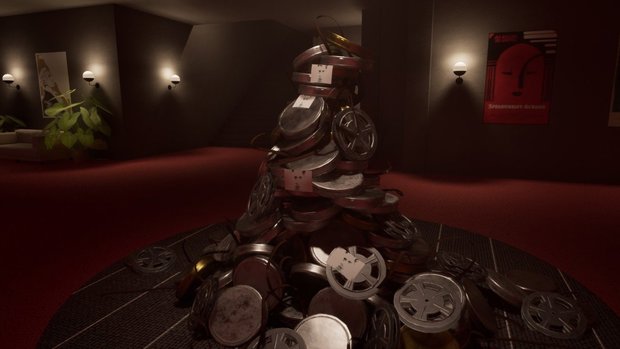
- 0 Comments
The lights are best lowered for this atmospheric FMV thriller that will have you on the edge of your seat
There’s no business like show business. Underneath the glam and glitz of Tinseltown, however, a dark, seedy underbelly lurks to ensnare hopeful spotlight seekers in the FMV fright fest Dead Take, twisting their hopes and dreams before unceremoniously spitting them back out again. Developer Surgent Studios takes aim at the lengths some will go to get their share of the limelight, and the terrifying cost of fame and fortune. There is probably a good amount of subtext hidden beneath the surface of this ritzy haunted-house thriller, but it’ll take someone smarter than myself to fully suss out the game’s more subtle undertones. Still, it delivers an original take on the horror genre, coming at it from an unexpected angle while managing to keep me on edge pretty much throughout the four hours it took to play through it.
The game takes place all in one night, following a party thrown by notorious film producer Duke Cain at his luxurious estate in the Hills the day before to commemorate the greenlighting of his next big movie project, The Last Voyage. Among the industry elites in attendance was Vinny Monroe, recently tapped to be the film’s leading man, a once-in-a-lifetime, career-making opportunity. You, on the other hand, play the role of Chase Lowry, fellow actor and Vinny’s friend/rival. You were also on the shortlist to make a name for yourself in Duke’s new movie, but narrowly missed out. Now, concerned that Vinny is not answering his phone, you’ve made your way to the darkened mansion with a heavy feeling of dread in your stomach, a certainty that something is off and Vinny is in trouble.
From the moment I set foot on Duke’s property, an uneasy sensation began to settle into my bones as well. It’s a dark, foreboding night, and the air all around is deathly silent as the spooky mansion façade lay ahead, seemingly ready to pounce on me at a moment’s notice. It’s all far too quiet and dark so soon after a posh Hollywood party filled with people. Instead, the structure is as empty and silent as the grave; something is definitely amiss here. The game does a good job making you feel unwelcome at all times, an interloper completely out of your comfort zone. For starters, there’s the locked front gate (the first puzzle you need to solve) barring access to the actual estate, not to mention the guest list you come across in the abandoned guardhouse with your name singled out at the bottom and adorned with a big question mark – you are clearly not welcome here.
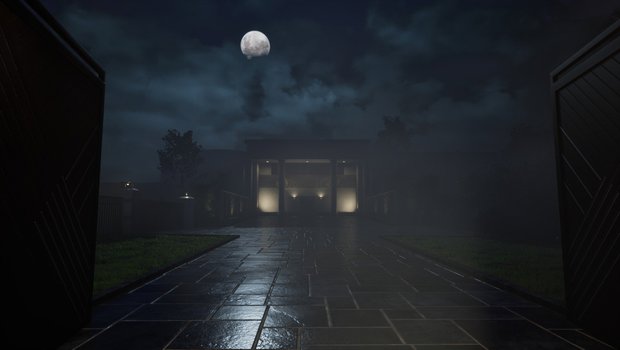
Even after you’ve found a way past the security gate and gained entry into the mansion proper, the feeling of intruding on something you’re not meant to see only intensifies, in more and more unnerving ways. The manor’s confetti-strewn foyer and other telltale signs of a lively bash – from black plastic garbage bags stuffed with uneaten food, to decorations collected but not yet disposed of, and half-finished drinks haphazardly set down all over the place – pose a chilling contrast to the absolute stillness all around you, as if scores of partygoers and house staff had simply vanished in the middle of their festivities just moments before you arrived.
But perhaps not everyone. It’s one thing to feel that you’re the only one in a deserted mansion but quite another to have the uneasy suspicion that you may not, in fact, be alone at all. As you enter the cavernous living room, your attention is grabbed by the single focal point at the room’s far end: a flashing red light over a recessed doorway, behind which a stairway heads downwards. Looks like there’s a basement, and someone – or something – is inviting you to descend into it.
This is the kind of gut-clenching sense of uneasiness that Dead Take relishes in making you feel. While the game isn’t above jump scares – there will be a few of those to deal with – the frights it dishes out are frequently more psychological in nature. It becomes increasingly difficult to be sure what is real and what is only in Chase’s head, as disturbances are often hinted at or implied rather than put on full display for you. While watching a video clip in the house’s screening theater, for example, a loud, thunderous knocking shatters the silence, and when you work up the nerve to open the door to check, you’re greeted with only an empty hall beyond.
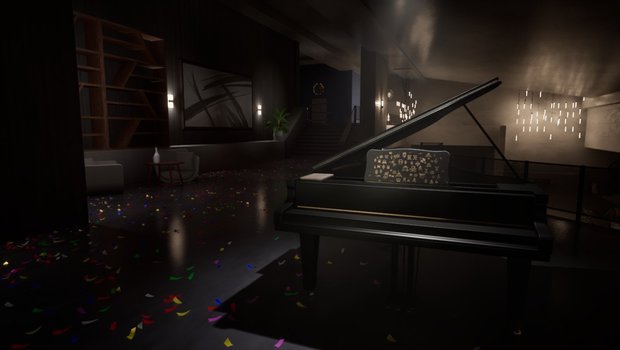
Likewise, while prowling around the manor’s deserted corridors, the producer’s loud screams will sometimes cut through the air around you without warning, putting your head on a swivel until you realize there wasn’t actually any physical threat nearby at all. Whether from disembodied voices or something actually moving in your peripheral vision, I’m not sure Chase is ever in any real danger. The game’s score – or lack thereof – adds to this general sense of uneasiness, often drowning you in nothing but the sound of your own footfall. Occasionally the deathly quiet gives way to more unsettling audio cues or ominous background music that’s almost industrial in its mood-inducing tonelessness.
The Cain mansion, while certainly spacious, is not so ridiculously sprawling as to be unwieldy to traverse. There’s the main building, with its first-floor living spaces and second-floor bedroom suites, as well as a basement level with everything a big-shot Tinseltown producer could want: dedicated rooms and equipment for auditioning, editing, and screening movies. There’s also the standalone pool house modeled in the style of an opulent Roman bath, a marble-floored garage, a small art gallery, and a spacious dining room now repurposed into a rehearsal space for The Last Voyage.
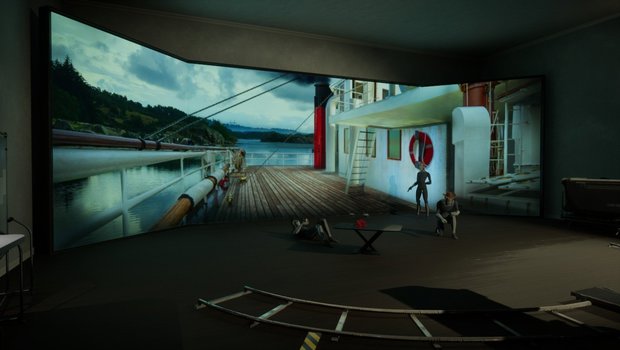
The estate is meticulously designed in a modern architectural style, and if it was lit properly and viewed during the daytime, it would look quite fetching. However, the sparse lighting here only makes it seem that much more hostile, and it wasn’t long before I dreaded every time I had to open a closed door, anxious about what new creepy sight I might stumble upon this time. While the mansion is largely pretty innocuous, it’s the anticipation of those times it isn’t that strains at the nerves, though safely enough to do so in an enjoyable way.
As the game gets going, your access is at first restricted, the many rooms requiring numeric codes or unique keys adorned with various symbols. In order to unlock them, Chase will need to solve a variety of puzzles throughout the mansion, oftentimes revolving around the movie business or Duke’s films in particular, like finding and placing several VHS tapes in a particular order or recreating a scene from a movie script using camera setups, props, and stand-in dummies (though this last one required too much trial-and-error guesswork for my liking). The game’s main puzzle mechanic, however, centers around finding, watching, and splicing together FMV interview clips and audition footage in the estate’s theater.
Throughout your free-roaming 3D exploration of the producer’s estate via traditional first-person WASD/mouse controls or gamepad, you’ll come across several thumb drives, each containing a video file that must be uploaded onto a PC workstation located in the screening room’s projectionist booth. The videos include snippets of audition and rehearsal footage from various actors involved with The Last Voyage, a few interviews with said actors, and even clips recorded directly for Duke by some of his industry collaborators. Once the room’s video projector is fixed (another puzzle you’ll have to first solve), any file uploaded can be played back from the screening theater next door, a process that Duke and his inner circle of collaborators have obviously made liberal use of over the years. In this case, however, merely watching the video clips, which provide a bit of character depth and development, is only half of the equation.
The software installed on the projectionist’s workstation (provided courtesy of the film studio attached to The Last Voyage expressly for this purpose) includes a splicing function that let Duke – and now you – edit together two distinct video files and watch the resulting product. While something like this is useful to a movie director for editing movie footage, you’ll be doing so for clues to help in solving puzzles around the manor. For example, there is a particularly uncomfortable clip of Duke (yelling from behind the camera) losing his cool as a cell phone loudly interrupts an audition. The tense ensuing exchange sees a visibly shaken Vinny mutter his phone’s unlock code, which you’ll be able to make later use of once you find his device. Other times, however, watching these clips just serves as a trigger for something in the house to change, allowing progress elsewhere. Curiously, there are a few instances where a spliced-together clip transforms into a brand new video, wholly separate from either of its parents, as impossible as that seems on the surface.
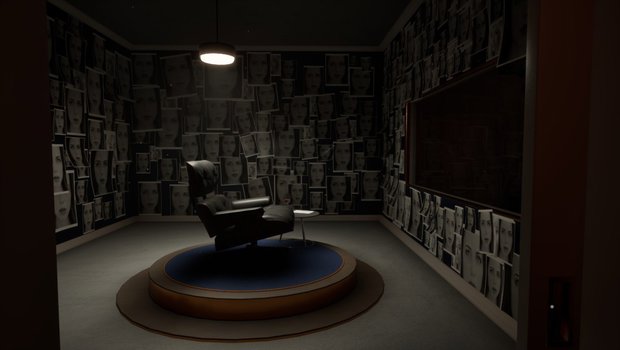
To make the whole process a little more puzzly, each video file is marked with a themed symbol that might give you a hint to which fit together (sun and moon symbols, for instance, are likely combinable), while choosing incompatible clips would simply fail to produce anything, much the same as a standard adventure game inventory puzzle. You could attempt to combine clips based on their actual content, but the act of loading up a video, walking to the next room to watch it, and returning to repeat the process again and again makes this method far more cumbersome. Thankfully, the actual splicing process is as simple as selecting the files and hitting a button; everything else is handled automatically by the software, which then adds the new clip to your desktop.
Despite the modern digs and the general “high-techiness” of it all, things quickly become more and more unhinged all around you. While puzzles tend to stay pretty grounded (play a certain tune on the piano to unlock a hidden compartment or collect the trident pieces of the pool house’s larger-than-life Triton statue and reassemble them), Chase’s grip on sanity quickly becomes tenuous. When I wasn’t hearing disembodied screams, close-up shots of the protagonist or his missing friend Vinny howling in terror or cackling maniacally began to regularly flash across my screen.
Soon enough I was catching glimpses of shadowy figures moving around the periphery of my vision while rooms began to stretch and lengthen in impossible ways, with doors leading to spaces that didn’t exist just moments earlier. Eventually, reality seemed to become entirely fragmented, with one particular set piece forcing me to stumble frantically around a dark room, hunting for chemicals and processing equipment to develop a film reel while demonic celluloid mannequins menacingly advanced toward me each time my back was turned.
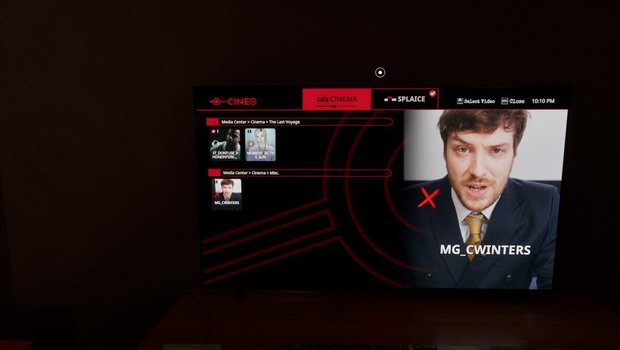
As Chase’s grip on reality became untethered, I started hoping for some sort of definitive explanation for what had occurred at Duke’s estate. A late-game black light allowed me to revisit the rooms I’d previously explored, to uncover disturbing messages and symbols scrawled across some of their walls, including the likes of pentagrams, horned goat’s heads, and pyramids with various glyphs inscribed. I also learned about a tragic event in Duke’s life and, putting two and two together, I built up an intriguing plot twist in my imagination revolving around a deal made with the devil and what price such a bargain would entail.
While this theory certainly added a layer of supernatural intrigue to what the game itself supplied, I’m still not entirely sure it was founded. There is some equally disturbing evidence of a more perverse nature that can be discovered with thorough digging, and the game is perfectly content leaving it all somewhat open to your own interpretation, with an ending that refuses to lean too far into either direction. Personally I would have preferred if it had committed to a single explanation, and having to draw my own conclusions felt a bit deflating (though that may say more about my own twisted mind than the game itself).
Although the only time you see any of the game’s characters is in their film clips, this is an FMV game so I’d be remiss not to mention some of the recognizable names and voices on the marquee. The headliners are Neil Newbon (Baldur’s Gate 3, Resident Evil Village) and Ben Starr (Final Fantasy XVI, Clair Obscur: Expedition 33) as Chase Lowry and Vinny Monroe, respectively. Further cast members include Alanah Pearce and voice performances by the likes of Laura Bailey and Matt Mercer. There’s even a cameo by Sam Lake that made me giggle – that’s right, Max Payne himself pops up as the film’s would-be director!
The actors all do a very good job (with the exception of Duke’s voice actor, who hams it up in a “cousin of the casting director” sort of way), but for me the show was stolen by Jane Perry playing the role of the producer’s wife Lia Cain, who turns in a powerful performance as the grieving, estranged spouse confronting the partner who abandoned her in the wake of a family tragedy. Even with less screen time than the main cast, it was her depiction of Duke as a cold, emotionless monster who sank himself into his work rather than comfort his heartbroken wife that solidified for me his descent into something evil and malign.
Final Verdict
Regardless of how much heavy lifting my imagination ended up needing to do, I can’t deny that the seeds were successfully planted by the game along the way, with plenty of tense atmosphere and a scattering of harrowing narrative clues providing fertile soil that allowed them to grow. Dead Take offers an interesting if not bombastic take on the haunted house horror theme, building up a solid feeling of tension from the start and presenting a ritzy setting in which to solve a handful of puzzles, propelled along by a solid live-action film production with great acting performances. Its final act teases sordid and deplorable events that the story doesn’t commit to paying off, but even without a hefty gut punch to decisively tie things up, there are still plenty of chills along the way, and at the very least it’s an experience that’ll stick in my memory for a good while to come.
Hot take
Combining a slick presentation, unsettling vibes, and an impressive list of talented actors, Dead Take is a solid FMV thriller with a unique Hollywood spin that would benefit most from an alternate ending.
Pros
- Intriguing thriller about the darkness festering beneath Hollywood’s glitz and glam
- Working with film clips offers a natural way to integrate FMV elements
- Atmosphere and tension so thick you could cut them with a clapperboard
Cons
- Narrative themes not well paid off in the end
- One major puzzle includes too much trial-and-error guesswork
Pascal played Dead Take on PC using a review code provided by the game's publisher.


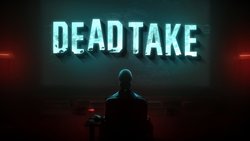
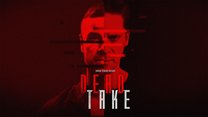
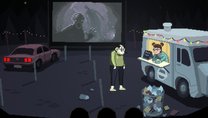






0 Comments
Want to join the discussion? Leave a comment as guest, sign in or register.
Leave a comment